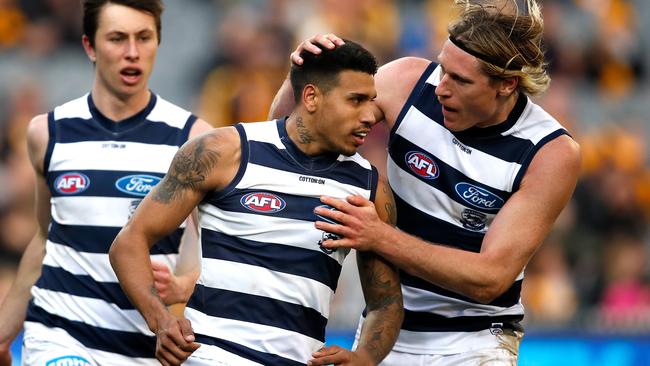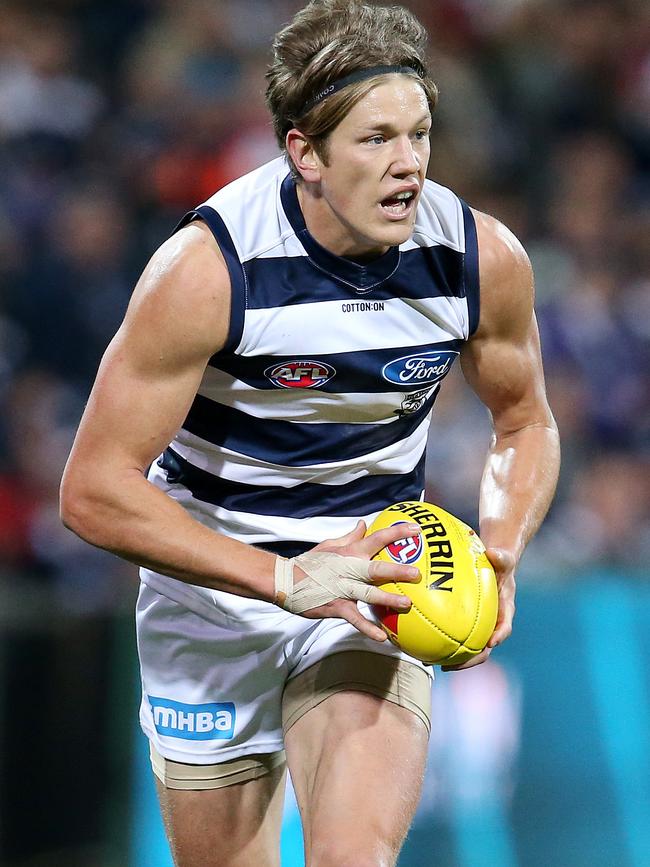Gary Buckenara analyses Geelong’s list after the 2018 season
GEELONG was right to stand firm on its trade demands for Tim Kelly. Gary Buckenara explains why as he analyses the Cats’ list and reviews was was a frustrating and ultimately disappointing season.

Geelong
Don't miss out on the headlines from Geelong. Followed categories will be added to My News.
IT WAS a frustrating and ultimately disappointing season for Geelong in a year that promised so much following the recruitment of Gary Ablett.
The big three - Ablett, Joel Selwood and Patrick Dangerfield - were joined by Mitch Duncan and first-year gun Tim Kelly to create a fab five, but it wasn’t enough to propel the Cats to the top four or to go one step further than their preliminary final finishes of 2016-17.
So, what went wrong?
BUCKY ON DEES: DO THEY REALLY NEED STEVEN MAY?
LIVE TRADES: DON’T MISS A MOVE ON DAY TWO
BUCKY ON BLUES: SHOULD CARTON TRADE PICK 1?
The list is full of talented players. There are a lot of A and B-grade players on the list; Ablett, Selwood, Dangerfield, Kelly, Hawkins, Menegola, Stewart, Tuohy, Menzel, Duncan and Blicavs.
On paper, boasting talent such as that should be enough to at least win a final, but I believe the Cats ultimately ran out of steam after battling a crippling injury list for most of the season.
All of Nakia Cockatoo (two games), Lachie Henderson (seven), Harry Taylor (eight), Cam Guthrie (13), Daniel Menzel (13), Scott Selwood (13) and Esava Ratugolea (eight) - who burst onto the scene to become a critical player in Chris Scott’s structure - spent large portions of the season on the sidelines.

Each one of those players is clearly in Geelong’s best 22.
The injuries to Henderson, Taylor and Ratugolea (as well as depth player Aaron Black) as key talls really hamstrung the Cats and the style of footy they were able to play.
The coaches would have had to adjust their structure, play players in different roles and come up with a slightly altered game style to combat the loss of such crucial players.
I have no doubt the way Geelong played throughout the season was far different to the style Scott had envisaged in the pre-season.
It wasn’t all bad, though. The absence of Henderson and Taylor cleared the path for the breakout seasons of Mark Blicavs, who was a revelation at full-back, Tom Stewart, Jake Kolodjashnij and the emergence of young gun Jack Henry.
Blicavs, Stewart and Kolodjashnij have been solid players but in 2018 they emerged as critical pieces for the future, while Henry looks to be a future star who is capable of having an impact at both ends of the ground.

I was also really impressed by the change in Tom Hawkins.
Last year I put the heat on him in my analysis of Geelong’s list because he wasn’t moving with the times and the way the current game is being played. He wanted the ball kicked in long where he could body his opponent and mark, that doesn’t work any more.
Hawkins obviously had a big pre-season, got himself fit, improved his aerobic capacity and got on his bike this year to run up the ground and work his opponents over.
He had a fantastic season, so well done Tom.
The issue in the ruck, with Rhys Stanley and Zac Smith unable to lock down the No.1 role, has also had an impact on the effectiveness on that star-studded midfield.
It was well-documented that the Cats struggled at clearances because they simply don’t have the gun ruckman in the Max Gawn/Brodie Grundy mould which became so important this year.
There’s no doubt Geelong as a club would be frustrated by the finish to the season but this has been a club that has been a consistent good performer without having to bottom out and I’ve got no doubt they’ll take lessons out of this season and come back bigger and better in 2019.
For next year’s campaign, the Cats will be boosted by the addition of premiership Bulldog Luke Dahlhaus and potentially Sydney speedster Gary Rohan.

One of the big stories of the trade period was there was no deal struck to send Tim Kelly to West Coast. Geelong has benefitted from the go-home factor in the last few years but list manager Stephen Wells always comes up with a fair deal and gets the trades done quickly, so I’m going to go in to bat for him here. The Cats were very clear on their demands for Kelly — a top-10 pick — and the Eagles couldn’t come up with what was required. That isn’t Geelong’s fault. When you’re drafted into the AFL you understand it’s also a business, so Kelly had to be aware that this was always going to be a possibility. I’m happy to see a club stand firm and not accept a lesser deal. I do feel for Kelly but Geelong was well within their rights to do what they did.
Kelly was dynamic in his debut season and slotted into senior football as seamlessly as we’ve seen. He’s a really silky mover whose ball use can let him down at times but he’s got so much upside he’s only going to get better.
The addition of Dahlhaus as a free agent is a good one because he adds the speed and forward pressure (when at his best) that the Cats have really lacked. It’s another smart move by Stephen Wells. The Cats have really lacked a pressure forward and at his best Dahlhaus can be really dynamic in that role, plus he can also go into the midfield and add some much-needed pace.
In terms of who’s left, Geelong hasn’t lost too much given McCarthy, Horlin-Smith and Thurlow are depth players who wanted more opportunities to play regular senior footy.
GEELONG’S LIST NEEDS
I think it’s critical Geelong heads to the draft with its first pick this year, barring the availability of a gun key forward to help Hawkins or a No.1 ruckman.
The Cats have an ageing list, particularly in the midfield, where, outside of first-year player Charlie Constable, their genuine midfielders - Ablett, J.Selwood, Dangerfield, Kelly, Duncan, Guthrie and S.Selwood - will be 23 or older next season. It’s time to bring in some young, top-end talent.
A quality forward to help Hawkins is a critical need but I’m not sure if there’s an experienced forward available to help immediately. That means Geelong’s hopes are pinned on Ratugolea and Wylie Buzza.
The Cats are also desperate for a dominant ruckman.
I don’t believe Stanley or Smith will ever develop into this type of player to give the gun midfielders first use.
The emergence of Blicavs and Henry as good key-defensive options has dug the club out of a hole with Taylor and Henderson nearing the end of their careers but more depth in this area is a need.
I also think more run and carry off half-back would assist Zach Tuohy and inject a bit more speed and creativity, which the Cats have lacked.


PLAYERS WHO NEED TO STEP UP IN 2019
There are a few Cats who will enter season 2019 under pressure to perform after disappointing seasons. It appears Stanley is now the preferred ruckman but he’s far from a dominant presence. Both he and Smith need to put in a heap of work over the off-season and into pre-season to get super fit to improve their running capabilities and spend a lot of time honing their ruck craft. If the Cats are to reap the rewards of having that star-studded midfield, then they need a ruckman who can at the very least break even with their opponents. Far too often both Stanley and Smith give up first use to the opposition.
Cockatoo has the talent to be an explosive and dynamic player - exactly what the Cats need up forward or even across half-back - but he simply can’t get on the park. In his four seasons he is yet to play more than 11 games and this year he managed just two. It’s not good enough from a player who was a top-10 selection. It’s time to knuckle down, get to the bottom of his soft-tissue issues and get his body right once and for all. Hopefully the Cats can get some reward on their investment starting next year.
BASKET CASE: BUCKY ANALYSES GOLD COAST’S LIST
TOP DEALS: BEST 50 TRADES OF ALL TIME
Henderson has a long history of injury problems and unfortunately they struck again this year. He has played more than 20 games just twice in his 11-year career and Geelong simply needs him to stand up. A fit Henderson (and possibly Taylor) at full-back alongside Blicavs allows Stewart and Kolodjashnij to take the third and fourth-best forwards and assume their more natural intercept and rebound roles. The fitness of both Henderson and Taylor is crucial to the structure of the backline.
Jordan Murdoch is the prototype for the modern midfielder but he’s never quite been able to perform at a consistent high level. After playing 22 games last year, he was again in and out of the Cats’ best side because he just doesn’t get enough of the ball. He averaged 14.9 disposals in 16 games this year but as a strongly-built tall utility with speed and a long kick, he must find more of the ball. If he stays at the club he’s surely on his last chance.
CRYSTAL BALL
Barring another season crippled by injuries to key players, Geelong should again be a top eight side that is pushing for a top-four finish. The premiership window is still open.


